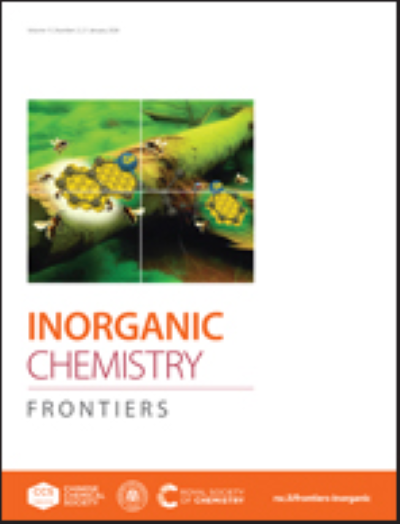异金属钙-碱金属芳基氧化物在尼龙-6废溶剂热醇解中的催化作用
IF 6.4
1区 化学
Q1 CHEMISTRY, INORGANIC & NUCLEAR
引用次数: 0
摘要
在本研究中,我们报道了同金属和异金属钙羰基氧化物的合成:[Ca(sal-Me)2(MeOH)]n (1), [Ca3(sal-Me)6(MeOH)2] (2), [Ca2Li2(sal-Me)6(THF)2] (3), [Ca2Na2(sal-Me)6(MeOH)4](4)和[Ca2K2(sal-Me)6(MeOH)4](5)。化合物1和2由金属钙与水杨酸甲酯(Hsal-Me)在甲醇(MeOH)中直接反应得到。一个类似的合成路线,加入一个等价物的碱金属(M ' = Li, Na, K)和四氢呋喃(THF),得到了杂金属衍生物3-5。这项工作的一个中心焦点是杂金属Ca 2 + -M +复合物的合成,其中只有13个例子以前被记录过。通过对反应途径的详细研究,鉴定出了中间化合物:[Ca3(sal-Me)6(THF)4] (2a)、[cal6 (sal-Me)8](6)和[Ca3Na4(sal-Et)10(Hsal-Et)2] (7) (Hsal-Et =水杨酸乙酯)。此外,在大气湿度条件下进行的反应产生了罕见的五核配合物[Ca4Na(μ5-OH)(sal-Et)8(MeOH)](8)和[Ca4K(μ5-OH)(sal-Et)8(EtOH)](9)。化合物1 - 9,连同之前报道[M”₆(sal-Me)₆](M⁺=李⁺(10),Na⁺(11),K⁺(12)),(Mg₂(sal-Et)₄(EtOH)₂](13)、(锌₄(sal-Me)₈](14),[M₂M '₂(sal-Me)₆(四氢呋喃)x] (M²⁺= Mg²⁺;M + = Li +(15)、Na +(16)、K + (17);M²+ = Zn²+;M + = Li +(18)、Na +(19)、K + (20);x = 0,2,4)和[Mg₄Na₂(sal- me)₆(sal)₂(THF)₄](21)作为聚酰胺废弃物化学回收的催化剂进行了评价。其中,异金属催化剂2、6和18-20在220℃下对尼龙-6的甲醇分解具有最高的催化活性。特别强调了反应条件和催化剂的高效率。分析了影响催化活性的关键因素和反应机理。本文章由计算机程序翻译,如有差异,请以英文原文为准。
Heterometallic Calcium–Alkali Metal Aryloxides as Catalysts for the Solvothermal Alcoholysis of Nylon-6 Waste
In this study, we report the synthesis of homometallic and heterometallic calcium aryloxides: [Ca(sal-Me)2(MeOH)]n (1), [Ca3(sal-Me)6(MeOH)2] (2), [Ca2Li2(sal-Me)6(THF)2] (3), [Ca2Na2(sal-Me)6(MeOH)4] (4), and [Ca2K2(sal-Me)6(MeOH)4] (5). Compounds 1 and 2 were obtained via direct reaction of metallic calcium with methyl salicylate (Hsal-Me) in methanol (MeOH). A similar synthetic route, incorporating one equivalent of an alkali metal (M′ = Li, Na, K) and tetrahydrofuran (THF), was used to obtain the heterometallic derivatives 3-5. A central focus of this work is the synthesis of heterometallic Ca²⁺–M′⁺ complexes, of which only 13 examples have been previously documented. A detailed investigation of the reaction pathways led to the identification of intermediate compounds: [Ca3(sal-Me)6(THF)4] (2a), [CaLi6(sal-Me)8]‧(6), and [Ca3Na4(sal-Et)10(Hsal-Et)2] (7) (Hsal-Et = ethyl salicylate). Additionally, reactions conducted under atmospheric moisture conditions yielded the uncommon pentanuclear complexes [Ca4Na(μ5-OH)(sal-Et)8(MeOH)] (8) and [Ca4K(μ5-OH)(sal-Et)8(EtOH)] (9). Compounds 1-9, along with previously reported [M′₆(sal-Me)₆] (M′⁺ = Li⁺(10), Na⁺(11), K⁺(12)), [Mg₂(sal-Et)₄(EtOH)₂] (13), [Zn₄(sal-Me)₈] (14), [M₂M′₂(sal-Me)₆(THF)x] (M²⁺ = Mg²⁺; M′⁺ = Li⁺(15), Na⁺(16), K⁺(17); M²⁺ = Zn²⁺; M′⁺ = Li⁺(18), Na⁺(19), K⁺(20); x = 0, 2, 4), and [Mg₄Na₂(sal-Me)₆(sal)₂(THF)₄] (21) were evaluated as catalysts for the chemical recycling of polyamide waste. Among them, the heterometallic catalysts 2, 6, and 18–20 exhibited the highest catalytic activity in the methanolysis of nylon-6 at 220 °C. Particular emphasis is placed on the reaction conditions and the high efficiency of the catalysts. Key factors influencing catalytic activity and the reaction mechanism are also analyzed.
求助全文
通过发布文献求助,成功后即可免费获取论文全文。
去求助
来源期刊

Inorganic Chemistry Frontiers
CHEMISTRY, INORGANIC & NUCLEAR-
CiteScore
10.40
自引率
7.10%
发文量
587
审稿时长
1.2 months
期刊介绍:
The international, high quality journal for interdisciplinary research between inorganic chemistry and related subjects
 求助内容:
求助内容: 应助结果提醒方式:
应助结果提醒方式:


